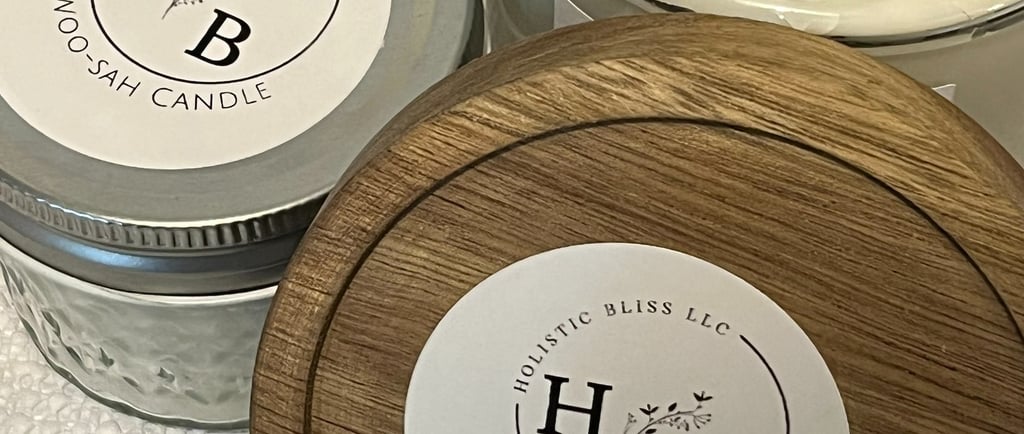Candles - Soy Wax, Beeswax, Paraffin, & More
Learn the key differences between soy, paraffin, and beeswax candles --how they burn, what they're made of, and which one might be right for you.
LEARN & GROWPRODUCTS
Jazmine Lewis
10/16/20236 min read


When you buy a candle, there are a multitude of options between different scents, colors, wax types, or a combination of those options. Some go for a favorite brand, or a particular scent. A color or vessel may be enough to draw you in.
When choosing a candle, those are very important factors but so should the ramifications to your health while burning the candle.
If you are anything like me, you go to the store for other things on your list, walk by or purposefully go to the candle section and pick one that is inviting. Before, I never thought about what my favorite scented candle could do to my body and home. This post is not meant to scare you, only inform you of the options you have when it comes to candles that lie outside of smell.
The main types of candle waxes are paraffin, beeswax, soy wax, coconut, palm wax, and gel wax. Each come with it’s perks and downfalls.
My favorite candles waxes to create with have been beeswax and soy wax. Featured in this post is our Apple Bourbon candle made using soy wax.
Using natural waxes eliminates the release of harmful chemicals like:
· Benzene – another colorless chemical that plays a major role in the production of gasoline. (Good Light Why paraffin wax is bad for you)
· Toluene – a chemical that is also found in tobacco smoke, vehicle emissions, and fumes from gasoline. It’s a colorless chemical that derives from crude oils. (Good Light Why paraffin wax is bad for you)
· Formaldehyde – when released, candles emit this highly toxic and flammable chemical. It is found in a variety of industries and used in automobile production, embalming, laboratories, as a disinfectant, and cosmetics. (Center for Disease Control and Prevention Formaldehyde)
Those chemicals affect your home, body, pets, plants, and overall environment.
These chemicals have been linked to causing cancer, headaches, damage inside our bodies like kidney and lung damage. Imagine, you light a candle from a big box store and decades later, you develop cancer or have significant irreversible lung damage. (Sonbolian 7 Health Issues Caused by Chemicals Found In Paraffin Wax)
To reiterate, this posting is NOT meant to scare you, only to inform you on the potential damage these types of products can cause. It’s convenient to pick up a new candle at the store while you’re there but think about how much making a conscious effort to purchase a natural candle can impact your life, especially for frequent users.
Types of Wax
Paraffin wax – one of the most common types of candle wax available today. Its low cost makes it a top competitor in the industry. However, as convenient, and cheap as it may be, its origin may be cause for concern. It is made by chilling petroleum; the crude oil is removed, and the remnants are manufactured into paraffin wax.
Soy wax – another common type of wax, derived from vegetable wax is made from soybean oil. It is a sustainable form of wax due to its production and how it originates. Most soybeans are produced primarily in Illinois, Indiana, and Iowa. Making soy wax primarily American made, sustainable, and eco-friendly. In the comparison of soy wax to paraffin, soy is natural, heavy chemical free and sustainable. (CandleScience What exactly is soy wax?)
Beeswax – As natural as it comes, beeswax is produced from a bees’ need to store pollen. It takes roughly 8 pounds of honey to produce 1 pound of wax. Depending on the age of the wax determines the color. Unbleached beeswax will initially turn white, but it has been known to appear red, black, yellow, and orange. Worker bees produce the wax within their abdomens and the wax, presenting as flakes, is typically transparent until chewed when it turns white. (The Beeswax Co. How bees make beeswax for our natural candles: Beeswax co..)
Palm wax – Palm wax is made from the separation process of hydrogenating palm oil from solid into liquid. Since it is derived from palm oil, it is also viewed as a sustainable method of candle wax making since it does not contain animal by product or petroleum like other waxes. (Cargill Palm Wax for candle making)
Coconut Wax – When the coconut meat is hydrogenated, and pressed, it produces an oil which is then processed into wax form. Because it is made from coconuts, it is also natural and biodegradable. It also takes less coconuts to produce wax, it also made for a relatively low cost making it one of the more sustainable wax options. (Admin 7 benefits of coconut wax in candles)
Gel Wax – Gel candles were always fascinating to look at, they are often clear or transparent gel with a variety of trinkets or objects inside the gel. Gel wax is a polymer resin-based type of wax. They burn longer than some of the other candle wax types. To ensure safety, proper research needs to be done on the type of materials put inside the resin wax, the type of wicks used, and the amount and type of fragrance used. (Escentuals All About Gel Candles)
Which candle burns the longest? Beeswax candles because it is denser than the other waxes allowing it to hold temperature better than other waxes. There are other factors to consider, primarily the size of the container used to house the wax candle. However, beeswax on average burns at a much slower rate than other forms of candles. (Dicke What type of candle burns the longest?)
What type of candle burns the cleanest? Beeswax candles or other natural forms of wax burn cleaner than paraffin wax candles. Beeswax candles are free of toxins that are released in the air while burning paraffin candles.
Which type of candle most potent smell? From my candle making experience, paraffin wax holds the best fragrance. It takes more of a fragrance load (which just means more fragrance oil used to produce a fragrance if the candle is lit or unlit). Beeswax and Soy wax, I have found require more fragrance oil to produce a fragrant smell.
Why did I choose to start off dye free? The easiest reason behind why I chose to start my candle making journey dye free was cost. While dyes are not overly expensive, they are an added cost and that could be used in other areas. Moreover, candle dyes are synthetic, and my aim is to remain natural with the products offered. One of my goals is to begin to introduce natural dyes from a supplier into candles and wax melts.
Type of wick? Why is that important? The options for wicks in a candle is almost as vast as the options that are available for waxes. The type of wick depends on preference and type of burn. Some produce a slow and even burn in the candle and others, like wood wicks offer a crackling sound. When searching for wicks that are going to burn clean, the best idea is to look for an unbleached cotton wick.
Type of containers and why does that matters? Believe it or not, the type of container used for candles and wax melts makes a difference in how safe it is to burn your candle. The containers used in our candles are designed to withstand heat. The wax melt containers are plastic, with a silicon mold waiting in my amazon cart, to be used in producing plastic free wax melts. I’ve seen really beautiful candles formed in wooden bowls or fruit peels; they were very aesthetically pleasing but I wondered how long it would burn before there was a concern in how hot the wood would get. There have also been pictures and videos that I’ve come across where people use bargain sourced (think Goodwill) containers. I think this is a great way to remain sustainable in your candle making efforts, but it is vitally important to ensure the orifice used can withstand the heat of a candle.
Resources
Admin, Fosse Living. “7 Benefits of Coconut Wax in Candles.” Fosse Living, Fosse Living, 21 June 2023, www.fosseliving.co.uk/blogs/news/7-benefits-of-coconut-wax-in-candles#:~:text=Coconut%20wax%20is%20produced%20by,a%20sizable%20about%20of%20product.
The Beeswax Co. “How Bees Make Beeswax for Our Natural Candles: Beeswax Co..” BeeswaxCo.Com, 10 Aug. 2023, beeswaxco.com/bees-making-wax/#:~:text=Bees%20consume%20honey%20(6%2D8,flakes%20on%20the%20bees’%20abdomen.
CandleScience. “What Exactly Is Soy Wax?” CandleScience, 2023, www.candlescience.com/learning/what-is-soy-wax/.
Cargill. “Palm Wax for Candle Making.” Cargill, 2023, www.cargill.com/bioindustrial/naturewax/palm-vegetable-oil.
Center for Disease Control. “Formaldehyde.” Centers for Disease Control and Prevention, Centers for Disease Control and Prevention, 21 June 2019, www.cdc.gov/niosh/topics/formaldehyde/default.html#:~:text=Formaldehyde%20(CH%E2%82%82O)%20is%20a%20colorless,antiseptics%2C%20medicines%2C%20and%20cosmetics.
Dicke, Rachel. “What Type of Candle Burns the Longest?” Creative Candles, Creative Candles, 11 Sept. 2023, creativecandles.com/blogs/blog/what-type-of-candle-burns-the-longest#:~:text=Beeswax%20is%20the%20Clear%20Winner,choice%20for%20longer%2Dlasting%20candles.
Escentuals, Rustic. “All About Gel Candles.” Recipes & Tutorials Crafting Library, The Crafting Library, 17 Nov. 2020, library.rusticescentuals.com/all-about-gel-candles/#:~:text=Gel%20is%20essentially%20a%20combination,luminescence%20than%20regular%20paraffin%20wax.
Good Light. “Why Paraffin Wax Is Bad for You.” GoodLight Natural Candles, 14 Sept. 2020, goodlightcandles.com/blogs/news/why-paraffin-wax-is-bad-for-you#:~:text=When%20paraffin%20candles%20burn%2C%20they,penta%2Ddecane%2C%20and%20hexadecane.
Sonbolian, Sharon. “7 Health Issues Caused by Chemicals Found In Paraffin Wax.” Happy Wax, Happy Wax, 10 Apr. 2020, https://happywax.com/blogs/from-the-blog/7-health-issues-caused-by-paraffin-wax. Accessed 16 Oct. 2023.
